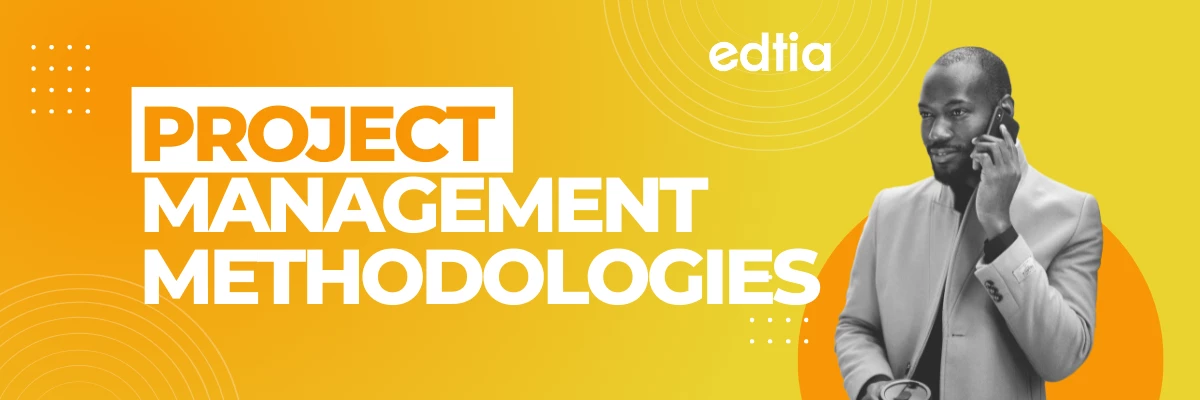Your Shopping Cart

We can help you solve company communication.



A project management methodology is a collection of regulations and practices that instruct you in managing your assignments to guarantee their performance. It's a framework that helps you manage your project in the best way possible. Project management is so crucial to organizations and teams. Opting for a suitable methodology help to make sure you're correctly mapping your project management methodology to your team type, project, organization, and goals to be effective.
Many factors will impact which project management methodology suits your project, team, and organization. Following are the steps that help you decide which method to opt for.
Waterfall methodology
The Waterfall method is a classic approach to project management. In it, duties and phases are completed in a linear, sequential manner, and each stage of the project must be met before the next begins.
The phases of Waterfall project management :
Progress courses in one direction, like a natural waterfall.
Also, like a natural waterfall, though, this can quickly get difficult. Since everything is mapped out initially, there's a lot of space for the mistake if anticipations don't fit reality. And there's no going back to a prior stage once it's completed.
Use this management methodology if:
The agile project management methodology arises from growing dissatisfaction with the linear approach of traditional project management methodologies.
Agile project management has sparked several specific sub-frameworks and methodologies, such as Scrum, kanban, and lean. The essential principles of agile project management methodologies are:
As such, agile project management methodologies usually involve short stages of work with periodic testing, reassessment, and adaptation throughout. In many agile methods, all work is counted to a backlog that teams can work through in each phase or cycle, with project managers or product owners prioritizing the backlog. Hence, teams understand what to focus on foremost.
Use this management methodology if:
A scrum is a form of agile project management, and you can think of it more like a framework than as a project management methodology in itself.
With Scrum, work is divided into short cycles known as "sprints," which usually stay about 1-2 weeks. Work is accepted from the backlog for each sprint iteration,
A Scrum Master guides small teams for the duration of the sprint. They examine their implementation in a "sprint retrospective" and make any necessary changes before starting the next sprint.
Use this management methodology if:
Kanban is another mode within agile project management.
Evolving from the manufacturing industry, the term "kanban" has denoted a framework in which tasks are visually represented as they progress through columns on a kanban board.
Kanban is great for giving everyone a quick visual overview of where each piece of work stands at any provided time. It also allows you to see where blockages are at risk of forming — if you witness one of your queues getting clogged, you'll know that that's a stage of your process that needs to be discussed.
When used as part of an agile project management methodology, performance of work in progress (WIP) limits is also standard. Work in progress limits the number of tasks in play at any time, indicating that you can only maintain a certain number of assignments in each column.
This stops your team from extending their energy on too many duties and instead guarantees that they can work more constructively by concentrating on per task separately.
Use this management methodology if:
Scrumban is a hybrid agile project management methodology with Scrum's nose and kanban's eyes.
The main advantage of scrumban as a method is that instead of deciding which task from the backlog to work on in each sprint at the outset, scrumban allows teams to continuously "pull" from the backlog established on their capability.
And utilizing work in improvement limits during your sprint cycle, you can keep a constant flow while still including project planning, reviews, and retrospectives.
Use this management methodology if:
Lean is another project management methodology that has its roots in manufacturing. It's all about using lean principles to maximize value and minimize waste in your project management methods.
While this referred initially to reducing bodily waste in the manufacturing process, it now refers to other wasteful practices in the project management process. These are 3Ms: Muda, mura, and muri.
Muda (wastefulness) consumes resources without adding value to the customer.
Mura (unevenness) occurs when you have overproduction in one area that throws all of your other sites out of whack, leaving you with too much inventory (wasteful!) or inefficient processes (also extravagant!).
Muri (overburden) occurs when there is too much strain on resources such as equipment and people, which can often result in breakdowns in machines and humans.
Using the fundamental principles of lean, a project manager can reduce these types of waste to create more efficient workflows.
Use this management methodology if:
Six Sigma is a method for improving processes, emphasizing consistency in output and impeccable quality.
A few different flavors are available, such as Lean Six Sigma and Agile Sigma. Still, ultimately Six Sigma is a business methodology that aims to eliminate defects and reduce variation by using its defined methods.
Six Sigma methods can optimize and improve existing processes or create new ones.
To enhance business processes, you can utilize the Six Sigma DMAIC methodology, which stands for the stages in the project methodology: Define, Measure, Analyze, Improve, Control.
To create new procedures or effects, you can utilize the Six Sigma DMADV process: Define, Measure, Analyze, Design, Verify.
Six Sigma methods can be applied alongside many other project management methodologies, like Lean and Agile, as a set of principles and procedures rather than a project management methodology.
Use this management methodology if:
You're examining for a set of principles and perspectives you can get with you to virtually every assignment and association.
The correct project management methodology can advance your project and support the project manager in bringing the best out of each team.
Whether you prefer the agile methods favored in IT project management or the more traditional waterfall project management and critical path methodology used in construction and manufacturing, every team has a project management methodology. No matter which strategy you choose, you need a collaborative, flexible, and easy-to-use assignment managing tool to sustain you. Selecting a team managing software that supports multiple methodologies — i.e., that doesn't seal you into one method or way of using it — like Teamwork means that every team in your organization has the freedom to work the way that works for them without surrendering features or complexity. No matter how you like to work, Teamwork helps your team replicate their best practices, provide observation and character, and continually enhance their processes.
Share this link via
Or copy link